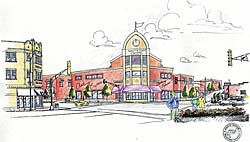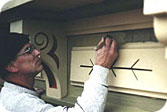 |
|||||||||
|
| home | our mission | contact us | issue archive |

May 2001 / from the source :: email this story to a friend

A Tale of Two Cities
By Clark RowleyThe need of St. Louis is to cultivate and grow our assets. Leadership is required to accomplish this. The assets which are valued and the tools which are used in order to achieve growth give insight into the quality of leadership and the potential for success.
Although it is a simplification, studying St. Louis leadership reveals two basic approaches. One group sees fiscal incentives and the municipal checkbook as prime tools to grow St. Louis. At the other end of the spectrum are those who perceive the people and the heritage of St. Louis as a foundation. Their attitude is that growth can be best achieved by building on the existing foundation.
The difference between these approaches is clearly illustrated by two recent news stories. One involves the efforts of the Southtown Coalition to influence redevelopment of the old Famous-Barr Southtown site at the corner of Chippewa and Kingshighway.

The other is a two-page interview with ex-deputy mayor for development for St. Louis, Michael Jones (St. Louis Post-Dispatch, "Imagine St. Louis," December 17, 2000). The article offers a telling quote: "Every time you come up with a solution to solve a systemic problem, it always requires some serious commitment of resources. And the current city structure has all the resources committed." If I understand his words, Jones is saying that if all fiscal resources are committed, then no other assets exist which can accomplish anything. By implication, he is saying that all that matters are fiscal assets.
Such checkbook leadership characterizes a medley of St. Louis projects, including football stadiums, downtown hotels, convention centers, tax-abated home and commercial construction, gambling boats, new taxes and programs for this and for that. Even inner-city lakes and a golf course have been suggested. All are touted as cure-alls for what ails St. Louis.
The problem is that cure-alls do not require thoughtful diagnoses. Quests for Holy Grails smother reality and require the suspension of common sense. There is no foundation work, nor do these searches enlist the hearts and energies of the citizenry. They become activities for people struggling to prove their leadership. They cater to narrow interests. Leadership supports a feeding frenzy for insiders who benefit from continued decline.
This behavior was illustrated by the City Living Foundation debacle. Spurred by the desire to find a panacea, checkbook leadership gravitates to those whose smooth and expensive words conceal quackery, deception and fraud. This process squanders precious resources and obscures solutions based on development of the real assets which St. Louis possesses. The city, despite enormous expenditures, is still in a state of decline.
Once proud and thriving, St. Louis is reduced to playing the futile game of doling out tax breaks, subsidies, TIFs and cash incentives to all comers, giving away the store. Meanwhile, leaders like Jones insist the way to salvation is more of the same. This process has led St. Louis down the path towards ruin. Yogi Berra's words ring true: "If you don't know where you are going, you might wind up somewhere else."
Contrast this to the efforts of the Southtown Coalition. Against seemingly hopeless odds, the coalition has gathered together more than thirty south St. Louis neighborhood organizations and interested allies to fight well-connected opponents who wish to put a big box Kmart store on the Famous Barr site.
The issues involved are at the heart of the problems of St. Louis. They include:
- Kmart ran its nearby Gravois Plaza store into the ground and then closed the doors.
- Auto-friendly, suburban-type general merchandise retailers in the city are a questionable investment. The much-ballyhooed St. Louis Marketplace site on Manchester is one example of a looming failure.
- The south side has put up with a vacant lot for years, the bitter harvest of an insider real estate deal. It benefited Sansone Group, a developer, not the local residents or the city, which originally had control of the site. Sansone has sold the property to another company acting on behalf of Kmart.
- Nearby neighborhoods have bent over backwards to influence the development process for the site. They have been insulted and ignored. The issues go on and on. The amazing ingredient, though, is the common-sense leadership displayed by the Southtown Coalition.
Their back-to-basics approach is founded on recognition of their prime assets: the people and the pride they have for their neighborhoods, and the architecture of these same neighborhoods, a shared and uniting heritage.
Building on this foundation has yielded a large mass of people focused on influencing the direction and destiny of the area in which they live. They have battled Kmart for months, regularly turning out hundreds of people to attend city hearings on the matter.
These assets — people and architecture — are the backbone of any successful St. Louis growth effort. But these assets are precisely those which so many St. Louis leaders deeply scorn or ignore. Of the architectural heritage, they advocate blowing it up or tearing it down. Of people, St. Louis has been losing that asset steadily for 50 years. Our leadership greets this as an interesting, perhaps an astonishing — but irrelevant — footnote. In reality, it is an indictment of failed leadership, of their blindness and impotence.
In two pages of words from Jones, not once does he raise the concept that people and their neighborhoods or architecture constitute something worthy of consideration. This blindness is reflected by the sorry state of the city and in the progress that the Southtown Coalition has made in pressing its case. Harnessed, these powerful assets are capable of pulling St. Louis from the mire of decay. But intelligent leadership is required to do this.

After all, it is people, more than anything else, who define a city. People, whether they are property owners or tenants, welfare recipients, laborers or white-collar workers, are the root source and process. What they do or don't do, which is related to their own self-respect and self-image, will make or break a city. The challenge to leadership is to direct and manage, to preserve and build on the self-respect and self-image, molding a quality product and a productive course of action.
Vince Lombardi summarized it nicely. "Individual commitment to a group effort — that is what makes a team work, a company work, a society work, a civilization work." St. Louis leadership misses this point. It is instinctive to the Southtown Coalition. There is a lesson here. If only it could be understood.
Clark Rowley is a resident of the Soulard neighborhood and was the charter president of the Soulard Restoration Group. He is the webmaster for the Soulard neighborhood on the CIN site at stlouis.missouri.org/soulard.
Church and State | Games | Expatriates | Communities | From the Source
It's All Happening | Young Minds | The Ordinary Eye | Elsewhere
Sights and Sounds | Media Shoegaze | A Day's Work | From the Editor© 2001 The Commonspace